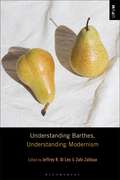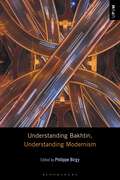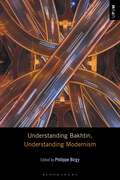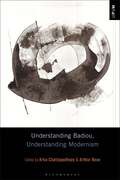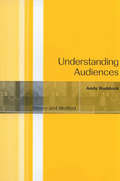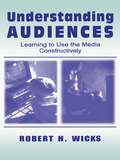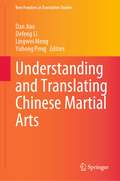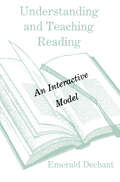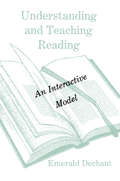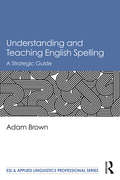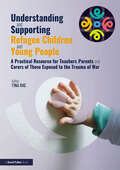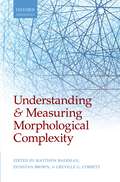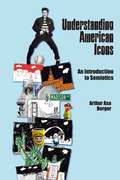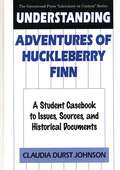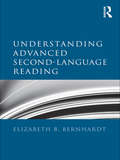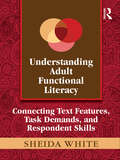- Table View
- List View
Understanding Barthes, Understanding Modernism (Understanding Philosophy, Understanding Modernism)
by Jeffrey R. Di Leo and Zahi ZallouaUnderstanding Barthes, Understanding Modernism is a general assessment of the modern literary and philosophical contributions of Roland Barthes. The first part of the volume focuses on work published prior to Barthes's death in 1980 covering the major periods of his development from Writing Degree Zero (1953) to Camera Lucida: Reflections on Photography (1980). The second part focuses both on the posthumously published material and the legacies of his work after his death in 1980. This later work has attracted attention, for example, in conjunction with notions of the neutral, gay writing, and critiques of everyday life.The third part is devoted to some of the critical vocabulary of Barthes in both the work he published during his lifetime, and that which was published posthumously.
Understanding Barthes, Understanding Modernism (Understanding Philosophy, Understanding Modernism)
Understanding Barthes, Understanding Modernism is a general assessment of the modern literary and philosophical contributions of Roland Barthes. The first part of the volume focuses on work published prior to Barthes's death in 1980 covering the major periods of his development from Writing Degree Zero (1953) to Camera Lucida: Reflections on Photography (1980). The second part focuses both on the posthumously published material and the legacies of his work after his death in 1980. This later work has attracted attention, for example, in conjunction with notions of the neutral, gay writing, and critiques of everyday life.The third part is devoted to some of the critical vocabulary of Barthes in both the work he published during his lifetime, and that which was published posthumously.
Understanding Bakhtin, Understanding Modernism (Understanding Philosophy, Understanding Modernism)
by Philippe BirgyExplores and illuminates the impact of the Russian philosopher Mikhail Bakhtin on our understanding of literary modernism.This volume explores the subject of modernism as seen through the lens of Bakhtinian criticism and in doing so offers a rounded and up-to-date example of the application of Bakhtinian theory to a field of research. The contributors consider the global spread of modernism and the variety of its manifestations as well as modernism's relationship to popular culture and its collective elaboration, which are dominant concerns in Bakhtin's thinking. As with other volumes in the Understanding Philosophy, Understanding Modernism series, the volume is divided into three parts. Part 1 provides readings of Bakhtin's work in the context of literary modernism. Part 2 features case studies of modernist art and artists and their relation to Bakhtinian theory. The final part provides a glossary of key terms in Bakhtin's work.
Understanding Bakhtin, Understanding Modernism (Understanding Philosophy, Understanding Modernism)
Explores and illuminates the impact of the Russian philosopher Mikhail Bakhtin on our understanding of literary modernism.This volume explores the subject of modernism as seen through the lens of Bakhtinian criticism and in doing so offers a rounded and up-to-date example of the application of Bakhtinian theory to a field of research. The contributors consider the global spread of modernism and the variety of its manifestations as well as modernism's relationship to popular culture and its collective elaboration, which are dominant concerns in Bakhtin's thinking. As with other volumes in the Understanding Philosophy, Understanding Modernism series, the volume is divided into three parts. Part 1 provides readings of Bakhtin's work in the context of literary modernism. Part 2 features case studies of modernist art and artists and their relation to Bakhtinian theory. The final part provides a glossary of key terms in Bakhtin's work.
Understanding Badiou, Understanding Modernism (Understanding Philosophy, Understanding Modernism)
by Arka Chattopadhyay and Arthur RoseIn his philosophical project, aesthetic orientation and political leanings, Alain Badiou is a product of, and a leading advocate for, European modernism. From the milieu of May 1968 to the contemporary 'postmodern' ethos, Badiou returns, time and again, to avant-garde modernist texts – aesthetic, political, philosophical and scientific – as inspiration for his response to present situations. Drawing upon disciplines as varied as architecture, cinema, theatre, music, history, mathematics, poetry and philosophy, Understanding Badiou, Understanding Modernism shows how Badiou's contribution to philosophy must be understood within the context of his decades-long conversation with modernist thinking. As with other volumes in the series, Understanding Badiou, Understanding Modernism follows a three part structure. The first section explores Badiou's readings of aesthetic, political and scientific modernities; both introducing his system and pointing to how Badiou offers manifold readings of modernism. The middle portion of the book connects Badiou's thought with the various strands of aesthetic, philosophical, amorous and political modernisms in relation to which it can be extended. The final section is a glossary of key concepts and categories that Badiou uses in his interface with modernism.
Understanding Badiou, Understanding Modernism (Understanding Philosophy, Understanding Modernism)
In his philosophical project, aesthetic orientation and political leanings, Alain Badiou is a product of, and a leading advocate for, European modernism. From the milieu of May 1968 to the contemporary 'postmodern' ethos, Badiou returns, time and again, to avant-garde modernist texts – aesthetic, political, philosophical and scientific – as inspiration for his response to present situations. Drawing upon disciplines as varied as architecture, cinema, theatre, music, history, mathematics, poetry and philosophy, Understanding Badiou, Understanding Modernism shows how Badiou's contribution to philosophy must be understood within the context of his decades-long conversation with modernist thinking. As with other volumes in the series, Understanding Badiou, Understanding Modernism follows a three part structure. The first section explores Badiou's readings of aesthetic, political and scientific modernities; both introducing his system and pointing to how Badiou offers manifold readings of modernism. The middle portion of the book connects Badiou's thought with the various strands of aesthetic, philosophical, amorous and political modernisms in relation to which it can be extended. The final section is a glossary of key concepts and categories that Badiou uses in his interface with modernism.
Understanding Audiences: Theory and Method
by Andy RuddockThe history of audience research tells us that the relationship between the media and viewers, readers and listeners is complex and requires multiple methods of analysis. In Understanding Audiences, Andy Ruddock introduces students to the range of quantitative and qualitative methods and invites his readers to consider the merits of both. Understanding Audiences: demonstrates how - practically - to investigate media power; places audience research - from early mass communication models to cultural studies approaches - in their historical and epistemological context; explores the relationship between theory and method; concludes with a consideration of the long-running debate on media effects; includes exercises which invite readers to engage with the practical difficulties of conducting social research.
Understanding Audiences: Theory and Method
by Dr Andy RuddockThe history of audience research tells us that the relationship between the media and viewers, readers and listeners is complex and requires multiple methods of analysis. In Understanding Audiences, Andy Ruddock introduces students to the range of quantitative and qualitative methods and invites his readers to consider the merits of both. Understanding Audiences: demonstrates how - practically - to investigate media power; places audience research - from early mass communication models to cultural studies approaches - in their historical and epistemological context; explores the relationship between theory and method; concludes with a consideration of the long-running debate on media effects; includes exercises which invite readers to engage with the practical difficulties of conducting social research.
Understanding Audiences: Learning To Use the Media Constructively (Routledge Communication Series)
by Robert H. WicksUnderstanding Audiences helps readers to recognize the important role that media plays in their lives and suggests ways in which they may use media constructively. Author Robert H. Wicks considers the relationship between the producers and the receivers of media information, focusing on how messages shape perceptions of social reality. He analyzes how contemporary media--including newspapers, film, television, and the Internet--vie for the attention of the audience members, and evaluates the importance of message structure and content in attracting and maintaining the attention of audiences. Wicks also examines the principles associated with persuasive communication and the ways in which professional communicators frame messages to help audiences construct meaning about the world around them. Among other features, this text: * describes the processes associated with human information processing; * presents an analysis of the principles associated with social learning in children and adults and explores the possibility that media messages may cultivate ideas, attitudes, and criticisms of this perspective; * explains how most media messages are framed to highlight or accentuate specific perspectives of individuals or organizations--challenging the notion of objectivity in media information messages; * considers the effects of media exposure, such as whether the contemporary media environment may be partially responsible for the recent rash of school violence among young people; * analyzes the Internet as an interactive medium and considers whether it has the potential to contribute to social and civic disengagement as it substitutes for human interaction; and * evaluates the principles of the uses and gratifications approach as they apply to the new media environment, including traditional media as well as popular genres like talk shows and developing media systems such as the Internet. Intended for upper-level undergraduate and graduate students who need to understand the nature of the media and how they interact with these messages, Understanding Audiences promotes the development of media literacy skills and helps readers to understand the processes associated with engaging them in media messages. It also offers them tools to apply toward the shaping of media in a socially constructive way.
Understanding and Translating Chinese Martial Arts (New Frontiers in Translation Studies)
by Dan Jiao Defeng Li Lingwei Meng Yuhong PengThe present book features some introductory discussions on martial arts for the international audience and highlights in brief the complexities of translating the genre into English, often from a comparative literature perspective. Martial arts, also known as Kungfu or Wushu, refer to different families of Chinese fighting styles over many centuries. Martial arts fiction, or Wuxia literature, is a unique genre that depicts adventures of martial artists in ancient China. Understanding martial arts and the Chinese culture and philosophy behind them creates an intriguing experience, particularly, for non-Chinese readers; translating the literature into English poses unparalleled challenges for translators not only because of the culture embedded in it but also the fascinating martial arts moves and captivating names of many characters therein.
Understanding and Teaching Reading: An Interactive Model
by Emerald DechantIn the words of Aldous Huxley, "Every man who knows how to read has it in his power to magnify himself, to multiply the ways in which he exists, to make his life full, significant and interesting." Few people question the value of reading; in fact, most extol its virtues. As our culture becomes more complex, reading plays an increasingly greater role in satisfying personal needs and in promoting social awareness and growth. In the last 20 years, the teaching of this invaluable skill has focused so intensely on comprehension and prediction from context that it has lost sight of the significance of automaticity and fluency in the word-identification process. Reading is a synthesis of word recognition and comprehension; thus, this text is about these basic processes and their integration. A common plea from teachers today is that research and psychology be translated into teaching behavior. Therefore, the aim of this book is twofold: one, to identify, report, organize, and discuss those bits of data, research and theory that are most relevant to the teacher's understanding of the reading process; and two, to help educators to interpret and apply theory and research data to everyday classroom teaching, as well as to the problems encountered frequently in developmental and remedial teaching.
Understanding and Teaching Reading: An Interactive Model
by Emerald DechantIn the words of Aldous Huxley, "Every man who knows how to read has it in his power to magnify himself, to multiply the ways in which he exists, to make his life full, significant and interesting." Few people question the value of reading; in fact, most extol its virtues. As our culture becomes more complex, reading plays an increasingly greater role in satisfying personal needs and in promoting social awareness and growth. In the last 20 years, the teaching of this invaluable skill has focused so intensely on comprehension and prediction from context that it has lost sight of the significance of automaticity and fluency in the word-identification process. Reading is a synthesis of word recognition and comprehension; thus, this text is about these basic processes and their integration. A common plea from teachers today is that research and psychology be translated into teaching behavior. Therefore, the aim of this book is twofold: one, to identify, report, organize, and discuss those bits of data, research and theory that are most relevant to the teacher's understanding of the reading process; and two, to help educators to interpret and apply theory and research data to everyday classroom teaching, as well as to the problems encountered frequently in developmental and remedial teaching.
Understanding and Teaching Primary English: Theory Into Practice
by James Clements Mathew TobinInspiring and supporting you to become an insightful, creative and professional teacher of primary English. Teaching children English is an opportunity to give them skills that will enrich their entire lives and is a crucial part of their intellectual development. Covering all major aspects of primary English and following the foundations set in the early years, this book takes you through your teacher training and into your early career in the classroom. Each topic explores what we know from theory and the latest research, and then demonstrates how you can use this understanding in practice. Drawing on the authors’ own knowledge and experiences in the classroom, the book is full of practical advice and strategies to support your own teaching, while also helping you develop your subject knowledge. Key topics include: · Reading and writing in the early years · Curriculum design and planning · Promotive reading for pleasure and teachers as readers · Teaching writing and its role as a form of communication · Vocabulary development and word knowledge · Assessment for formative and summative purposes · Oracy and spoken language development
Understanding and Teaching Primary English: Theory Into Practice
by James Clements Mathew TobinInspiring and supporting you to become an insightful, creative and professional teacher of primary English. Teaching children English is an opportunity to give them skills that will enrich their entire lives and is a crucial part of their intellectual development. Covering all major aspects of primary English and following the foundations set in the early years, this book takes you through your teacher training and into your early career in the classroom. Each topic explores what we know from theory and the latest research, and then demonstrates how you can use this understanding in practice. Drawing on the authors’ own knowledge and experiences in the classroom, the book is full of practical advice and strategies to support your own teaching, while also helping you develop your subject knowledge. Key topics include: · Reading and writing in the early years · Curriculum design and planning · Promotive reading for pleasure and teachers as readers · Teaching writing and its role as a form of communication · Vocabulary development and word knowledge · Assessment for formative and summative purposes · Oracy and spoken language development
Understanding and Teaching Primary English: Theory Into Practice
by James Clements Mathew TobinInspiring and supporting you to become an insightful, creative and professional teacher of primary English. Teaching children English is an opportunity to give them skills that will enrich their entire lives and is a crucial part of their intellectual development. Covering all major aspects of primary English and following the foundations set in the early years, this book takes you through your teacher training and into your early career in the classroom. Each topic explores what we know from theory and the latest research, and then demonstrates how you can use this understanding in practice. Drawing on the authors’ own knowledge and experiences in the classroom, the book is full of practical advice and strategies to support your own teaching, while also helping you develop your subject knowledge. Key topics include: · Reading and writing in the early years · Curriculum design and planning · Promotive reading for pleasure and teachers as readers · Teaching writing and its role as a form of communication · Vocabulary development and word knowledge · Assessment for formative and summative purposes · Oracy and spoken language development
Understanding and Teaching English Spelling: A Strategic Guide (ESL & Applied Linguistics Professional Series)
by Adam BrownConcise and engaging, this text provides pre-service and practicing English language teachers with the knowledge they need to successfully teach the spelling of English. Offering context and explanation for the English spelling system as well as uniquely addressing specific problems in learning the spelling of English words, this book empowers readers with strategies for coping with these problems. Divided into six accessible sections, Brown covers the history of English spelling, the influence of technology on spelling, the role of punctuation, the features of present-day English spelling, teaching strategies for coping with difficult spelling, and the future of spelling and literacy. The short, digestible chapters include practical learning objectives and end-of-chapter exercises to help teachers understand and explain English spelling concepts.
Understanding and Teaching English Spelling: A Strategic Guide (ESL & Applied Linguistics Professional Series)
by Adam BrownConcise and engaging, this text provides pre-service and practicing English language teachers with the knowledge they need to successfully teach the spelling of English. Offering context and explanation for the English spelling system as well as uniquely addressing specific problems in learning the spelling of English words, this book empowers readers with strategies for coping with these problems. Divided into six accessible sections, Brown covers the history of English spelling, the influence of technology on spelling, the role of punctuation, the features of present-day English spelling, teaching strategies for coping with difficult spelling, and the future of spelling and literacy. The short, digestible chapters include practical learning objectives and end-of-chapter exercises to help teachers understand and explain English spelling concepts.
Understanding and Supporting Refugee Children and Young People: A Practical Resource for Teachers, Parents and Carers of Those Exposed to the Trauma of War
by Tina RaeThis book is the go-to resource for those parents and professionals seeking to support children through the trauma of war and conflict. Not only does it provide the evidence base for effectively integrating refugee children into their new schools, but it also introduces the reader to a range of key tools and strategies to both understand and manage anxiety and trauma -related behaviours. Practical and user-friendly, it demystifies the process of talking about difficult topics, providing helpful advice on how to do this in a trauma informed way, making use of effective tools from therapeutic approaches to help our children and ourselves remain regulated and able to engage in post-traumatic growth.
Understanding and Measuring Morphological Complexity
This book aims to assess the nature of morphological complexity, and the properties that distinguish it from the complexity manifested in other components of language. Of the many ways languages have of being complex, perhaps none is as daunting as what can be achieved by inflectional morphology: this volume examines languages such as Archi, which has a 1,000,000-form verb paradigm, and Chinantec, which has over 100 inflection classes. Alongside this complexity, inflection is notable for its variety across languages: one can take two unrelated languages and discover that they share similar syntax or phonology, but one would be hard pressed to find two unrelated languages with the same inflectional systems. In this volume, senior scholars and junior researchers highlight novel perspectives on conceptualizing morphological complexity, and offer concrete means for measuring, quantifying and analysing it. Examples are drawn from a wide range of languages, including those of North America, New Guinea, Australia, and Asia, alongside a number of European languages. The book will be a valuable resource for all those studying complexity phenomena in morphology, and for theoretical linguists more generally, from graduate level upwards.
Understanding American Icons: An Introduction to Semiotics
by Arthur Asa BergerThis brief, student-friendly introduction to the study of semiotics uses examples from 25 iconic locations in the United States. From Coney Island to Las Vegas, the World Trade Center to the Grand Canyon, Berger shows how semiotics offers a different lens in understanding locations taken for granted in American culture. He recasts Disneyland according to Freud, channels the Mall of America through Baudrilliard, and sees Mount Rushmore through the lens of Gramsci. A seasoned author of student texts, Berger offers an entertaining, non-threatening way to teach theory to undergraduates and that will fit ideally in classes on cultural studies, American studies, social theory, and tourism.
Understanding American Icons: An Introduction to Semiotics
by Arthur Asa BergerThis brief, student-friendly introduction to the study of semiotics uses examples from 25 iconic locations in the United States. From Coney Island to Las Vegas, the World Trade Center to the Grand Canyon, Berger shows how semiotics offers a different lens in understanding locations taken for granted in American culture. He recasts Disneyland according to Freud, channels the Mall of America through Baudrilliard, and sees Mount Rushmore through the lens of Gramsci. A seasoned author of student texts, Berger offers an entertaining, non-threatening way to teach theory to undergraduates and that will fit ideally in classes on cultural studies, American studies, social theory, and tourism.
Understanding Adventures of Huckleberry Finn: A Student Casebook to Issues, Sources, and Historical Documents (The Greenwood Press "Literature in Context" Series)
by Claudia Durst JohnsonSince the time of its publication in 1884, Adventures of Huckleberry Finn has generated heated controversy. One of the most frequently banned books in the history of literature, it raises issues of race relations, censorship, civil disobedience, and adolescent group psychology as relevant today as they were in the 1880s. This collection of historical documents, collateral readings, and commentary captures the stormy character of the slave-holding frontier on the eve of war and highlights the legacy of past conflicts in contemporary society. Among the source materials presented are: memoirs of fugitive slaves, a river gambler, a gunman, and Mississippi Valley settlers; the Southern Code of Honor; rules of dueling; and an interview with a 1990s gang member.These materials will promote interdisciplinary study of the novel and enrich the student's understanding of the issues raised. The work begins with a literary analysis of the novel's structure, language, and major themes and examines its censorship history, including recent cases linked to questions of race and language. A chapter on censorship and race offers a variety of opposing contemporary views on these issues as depicted in the novel. The memoirs in the chapter Mark Twain's Mississippi Valley illuminate the novel's pastoral view of nature in conflict with a violent civilization resting on the institution of slavery and shaped by the genteel code of honor. Slavery, Its Legacy, and Huck Finn features 19th-century pro-slavery arguments, firsthand accounts of slavery, the text of the Missouri Compromise of 1820 and the Fugitive Slave Law of 1850, and opposing views on civil disobedience from such 19th- and 20th-century Americans as Ralph Waldo Emerson, Stephen A. Douglas, and William Sloane Coffin. Nineteenth-century commentators on the Southern Code of Honor and Twain's sentimental cultural satire directly relate the novel to the social and cultural milieu in which it was written. Each chapter closes with study questions, student project ideas, and sources for further reading on the topic. This is an ideal companion for teacher use and student research in English and American history courses.
Understanding Advanced Second-Language Reading
by Elizabeth B. BernhardtWhat distinguishes this book is its broad, yet thorough, view of theory, process, and research on adult second-language reading. Offering extensive discussions of upper-register second-language texts (both expository and narrative) that adult second-language readers encounter daily across the globe, it also presents an assessment schema for second-language text comprehension as well as for the assessment of teaching. Understanding Advanced Second-Language Reading: includes languages other than English in the discussion of second language reading is firmly anchored in a theory of second language reading ─ the concept of compensatory processing emphasizes the multi-dimensionality and dynamic nature of L2 reading development focuses on comprehension of upper-register literary texts balances theory and instructional practices. Filling the need for a coherent, theoretically consistent, and research-based portrait of how literate adolescents and adults comprehend, and learn to comprehend, at greater levels of sophistication and whether that ability can be enhanced by instruction, this is a must-have resource for reading and second-language researchers, students, and teachers.
Understanding Advanced Second-Language Reading
by Elizabeth B. BernhardtWhat distinguishes this book is its broad, yet thorough, view of theory, process, and research on adult second-language reading. Offering extensive discussions of upper-register second-language texts (both expository and narrative) that adult second-language readers encounter daily across the globe, it also presents an assessment schema for second-language text comprehension as well as for the assessment of teaching. Understanding Advanced Second-Language Reading: includes languages other than English in the discussion of second language reading is firmly anchored in a theory of second language reading ─ the concept of compensatory processing emphasizes the multi-dimensionality and dynamic nature of L2 reading development focuses on comprehension of upper-register literary texts balances theory and instructional practices. Filling the need for a coherent, theoretically consistent, and research-based portrait of how literate adolescents and adults comprehend, and learn to comprehend, at greater levels of sophistication and whether that ability can be enhanced by instruction, this is a must-have resource for reading and second-language researchers, students, and teachers.
Understanding Adult Functional Literacy: Connecting Text Features, Task Demands, and Respondent Skills
by Sheida White"This is a genuinely scholarly work ... It is based on [analysis of] the most up-to-date quantitative surveys that we have on adult literacy. These surveys are the gold standard in terms of documenting adult literacy in the United States ...The author analyzes these extensive surveys and puts them into a theoretical context in a way that has not been done before." – Rosemary J. Park, University of Minnesota "I don’t know of any book providing the same information. There is a shortage of literature in this area and the book is an excellent contribution." – Dolores Perin, Teachers College, Columbia University "The contribution of the theory is important – not only to adult literacy but to our understanding of the reading process at nearly every level ... Additionally, the application of multidimensional item response modeling to the new TTR theory offers a tantalizing view of how the predictive validity of a theory might be tested and used to provide practical results." – Larry Mikulecky, Indiana University Very often, individual differences in literacy performance are understood exclusively in terms of the characteristics of the reader. Drawing on a rich array of empirical research, the author presents a detailed and highly integrative new theory of functional literacy. The text-task-respondent (TTR) theory of functional literacy offers improved understanding of how successful performance on everyday literacy tasks involves a dynamic relationship among the text, the task, and the reader. This book will appeal primarily to assessment developers who wish to select tasks and texts of varying difficulty to yield more precise estimates of adult literacy; to researchers who study cognitive, linguistic, and discourse processes; and to teachers who want to find new ways to increase text comprehension among students, including English language learners and struggling readers. The text is appropriate for an advanced course in adult education, discourse analysis, educational measurement, educational psychology, literacy, or linguistics – or as a reference work for those interested in literacy.
